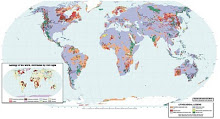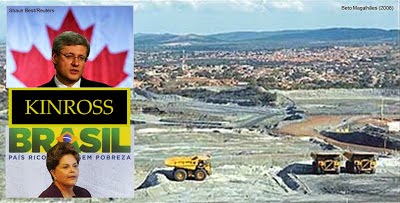A global arsenic issue: Paracatu and the world on a King’s row of death
Who cares for Latin America – a part of our planet – and who cares for Paracatu people – a part of humankind? Worldwide attention and immediate action needed.
By Sergio U. Dani (*)
A genocide is about to happen in Paracatu, a city in Latin America, Brazil. Following a permit issued last Friday, August 21, Canadian Kinross Gold Corporation is prepared to release one million tons of arsenic, the king of poisons, in the air, soils and drinking water of 90,000 people. A fistful of Brazilian authorities support this genocide, capitalizing on the lack of resistance of a poor and semi-illiterate people.
Gold mining is among the most important sources of arsenic release into the environment because gold is closely associated with arsenopyrite which is the principal ore of arsenic [1].
The mine tailings to be produced in the next thirty years as a result of the permitted Kinross mining activities in Paracatu will contain some 1.2 million tonnes of inorganic arsenic [2].
The release of inorganic arsenic from this single gold mine is equivalent to 25% the world cumulative ndustrial-age anthropogenic As production [3], an amount that would suffice to make sick and kill tenfold the 7 Billion people presently living on Earth [4].
Incredibly enough, all this arsenic is going to be released on top of the only source of drinking water of 90,000 people, in such a way as to set the stage for a true genocide [5,6].
Volatilization of the arsenic from Paracatu is bound to increase the overall arsenic burden worldwide [7-10].
The Paracatu issue is beyond national boundaries. It has to do with an unbelievable abuse and a crime against humankind and our planet, in a time of shrinking natural resources. What use is gold in such a world?
The World Health Organization has been alerted about this world largest genocide and environmental contamination by deliberate arsenic release. We have called the attention of WHO and other people and institutions worldwide to take a decided action to avoid this genocide and environmental contamination.
I believe that each one of us has a share in the responsibility for these crimes. It is each one of us who, day after day, year after year, tolerates to live with such crimes, watch them being perpetrated and do nothing against them.
No one should remain insensible. It is our planet, it is our humankind.
(*) S. Dani is a M.D., D.Sc. writing from Göttingen, Germany. August 25, 2009.
References:
[1] Hurlbut, C. S. & Klein, C. Manual of Mineralogy, 20th ed. (1985).
[2] Henderson, R. D. Paracatu Mine Technical Report, Kinross Gold Corporation, July 31, 2006, available at: http://www.kinross.com/operations/pdf/Technical-Report-Paracatu.pdf, accessed 2009.
[3] Han, F. X. et al. Assessment of global industrial-age anthropogenic arsenic contamination. Naturwissenschaften 90:395-401 (2003).
[4] Arena, J. M. & Drew, R. H., Eds. Poisoning. Fifth edition. Charles C Thomas, Springfield, 1,128 pp. (1986).
[5] Polizzotto, M. L., Kocar, B. D., Benner, S. G., Sampson, M. & Fendorf, S. Near-surface wetland sediments as a source of arsenic release to ground water in Asia. Nature 454:505-8 (2008).
[6] Smith, A. H., Steinmaus, C., Yuan, Y., Liaw, J. & Hira-Smith, M. M. High concentrations of arsenic in drinking water result in the highest known increases in mortality attributable to any environmental exposure, Proceedings of a Symposium: Arsenic – The Geography of a Global Problem, Royal Geographical Society: Arsenic Conference, 29th August 2007, presentation available:
www.geog.cam.ac.uk/research/projects/arsenic/symposium, accessed 2009.
[7] Tamaki, S. & Frankenberger, W. T. Jr. Environmental biochemistry of arsenic. Rev. Environ. Cont. Toxicol. 124:79-110 (1992).
[8] Baker-Austin, C. et al. Extreme arsenic resistance by the acidophilic archaeon 'Ferroplasma acidarmanus' Fer1. Extremophiles 11:425-34 (2007)
[9] Cernansky, S., Kolencík, M., Sevc, J., Urík, M. & Hiller, E. Fungal volatilization of trivalent and pentavalent arsenic under laboratory conditions. Bioresour. Technol. 100:1037-40 (2009).
[10] Qin, J. et al. Biotransformation of arsenic by a Yellowstone thermoacidophilic eukaryotic alga. Proc. Natl. Acad. Sci. USA 106:5213-7 (2009).
Friday, October 9, 2009
Subscribe to:
Post Comments (Atom)




No comments:
Post a Comment